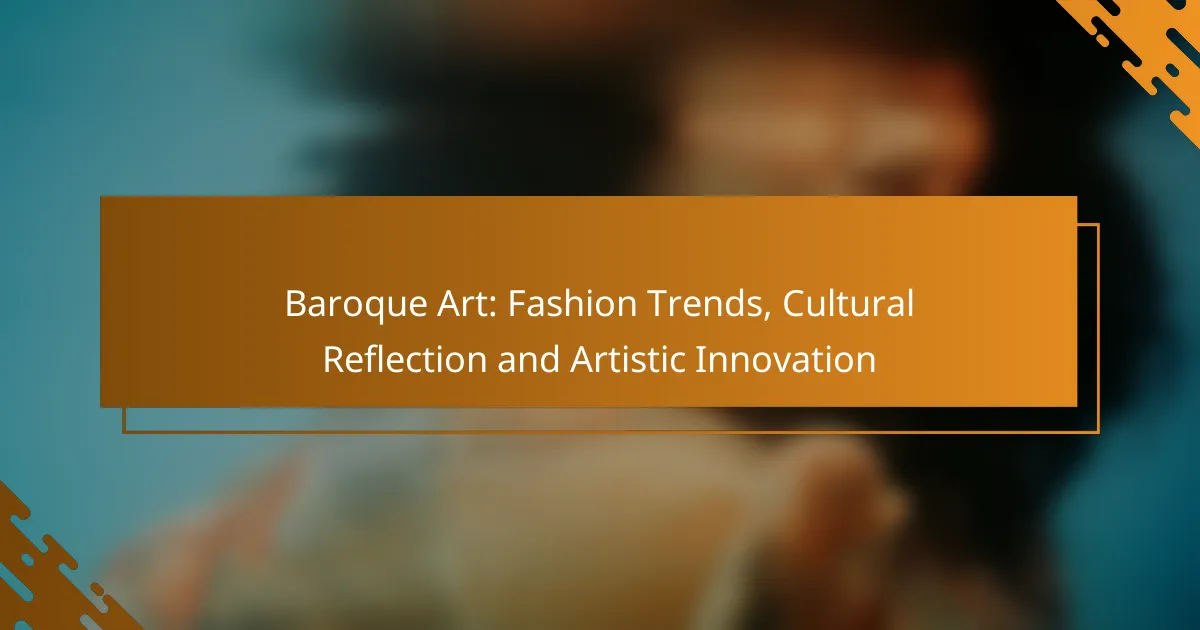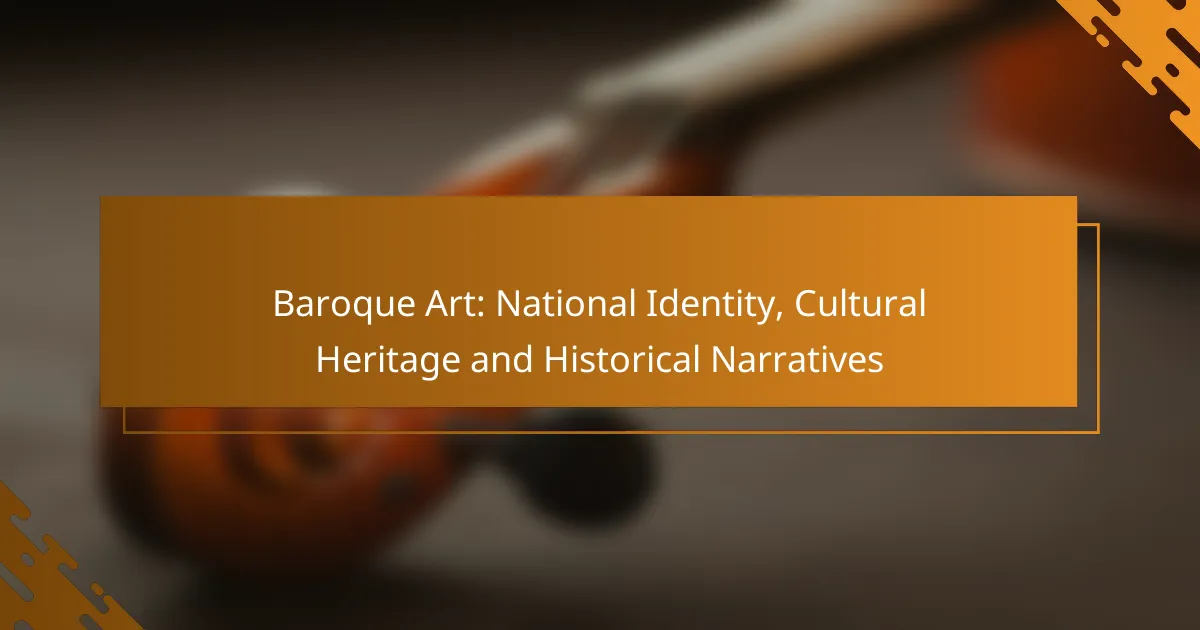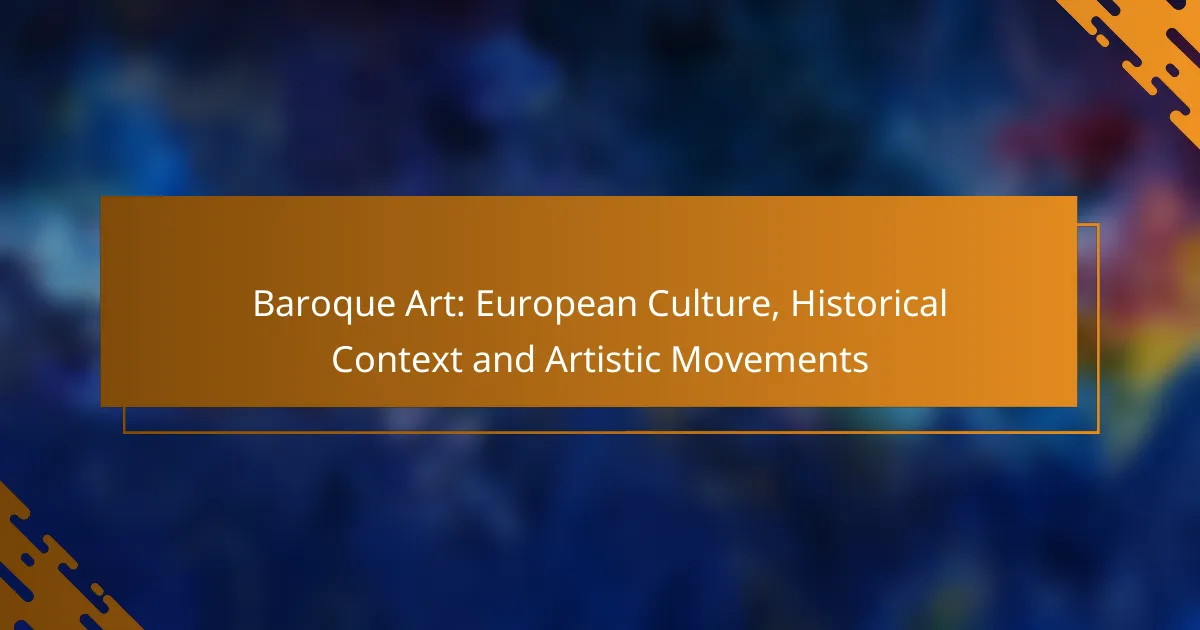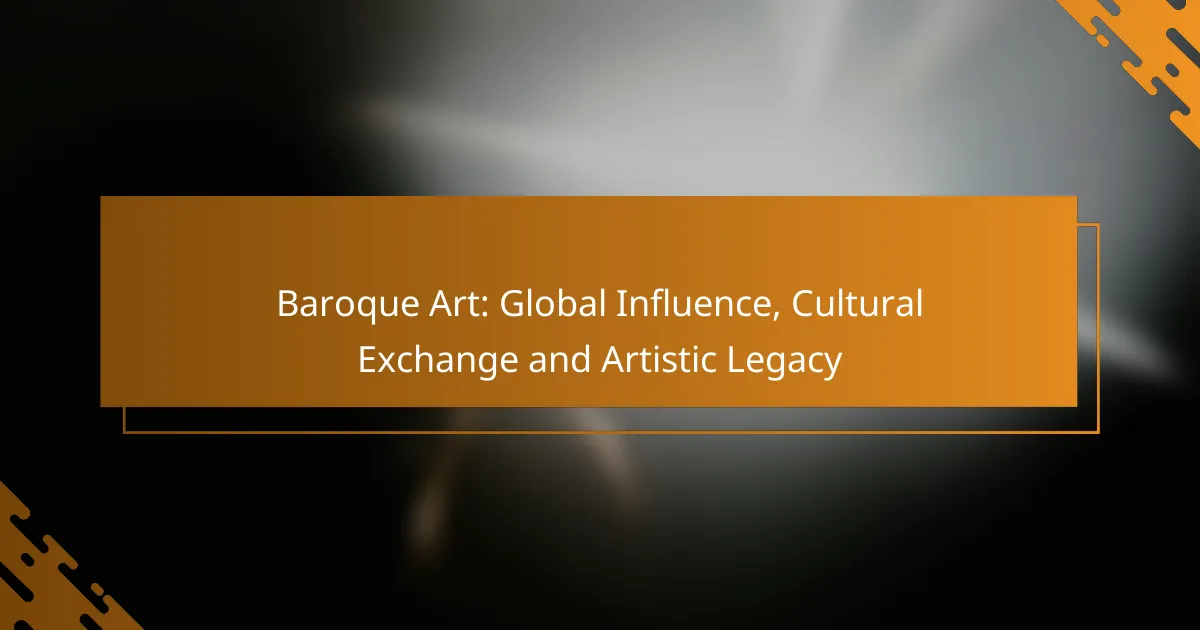Baroque Art, flourishing from the late 16th to the early 18th century, is renowned for its grandeur and intricate details, which continue to influence modern fashion trends. This artistic movement not only reflects the cultural dynamics of its time, revealing the interplay of social hierarchies and political power, but also advanced artistic innovation through dramatic expression and emotional depth. The legacy of Baroque Art remains evident in contemporary design, showcasing its enduring impact on both art and fashion.

How does Baroque Art influence modern fashion trends?
Baroque Art significantly influences modern fashion trends through its emphasis on grandeur, intricate details, and dramatic aesthetics. Designers draw inspiration from the opulence of the Baroque period, incorporating similar elements into contemporary clothing collections.
Baroque-inspired clothing collections
Many fashion brands have launched collections that reflect Baroque influences, featuring rich colors, elaborate embroidery, and luxurious silhouettes. These collections often evoke the dramatic flair of the 17th and 18th centuries, appealing to consumers seeking unique and statement-making pieces.
For example, seasonal collections may include garments with ruffles, lace, and brocade fabrics, reminiscent of Baroque styles. Such designs are popular in both high street and luxury fashion markets, showcasing the enduring appeal of this artistic movement.
Impact on haute couture designers
Haute couture designers frequently reference Baroque Art in their creations, using its themes to craft visually stunning garments. Designers like Alexander McQueen and Dolce & Gabbana have incorporated Baroque motifs, emphasizing opulence and theatricality in their runway shows.
This influence is evident in the use of dramatic silhouettes and ornate detailing, which elevate the garments to works of art. The integration of Baroque elements allows these designers to push boundaries and create memorable fashion statements.
Use of opulent fabrics and patterns
Modern fashion often features opulent fabrics such as velvet, silk, and brocade, which were staples during the Baroque era. These materials not only provide a luxurious feel but also enhance the visual impact of the clothing.
Patterns inspired by Baroque Art, including intricate floral designs and bold geometric shapes, are commonly used in contemporary collections. The combination of rich textures and striking patterns creates a sense of depth and drama, appealing to fashion enthusiasts.
Modern reinterpretations of Baroque styles
Contemporary designers reinterpret Baroque styles by blending traditional elements with modern aesthetics. This fusion results in innovative designs that maintain the essence of Baroque while appealing to today’s fashion sensibilities.
For instance, minimalist cuts may be paired with Baroque-inspired embellishments, creating a striking contrast. This approach allows for versatility, making Baroque influences accessible to a broader audience while retaining their historical significance.
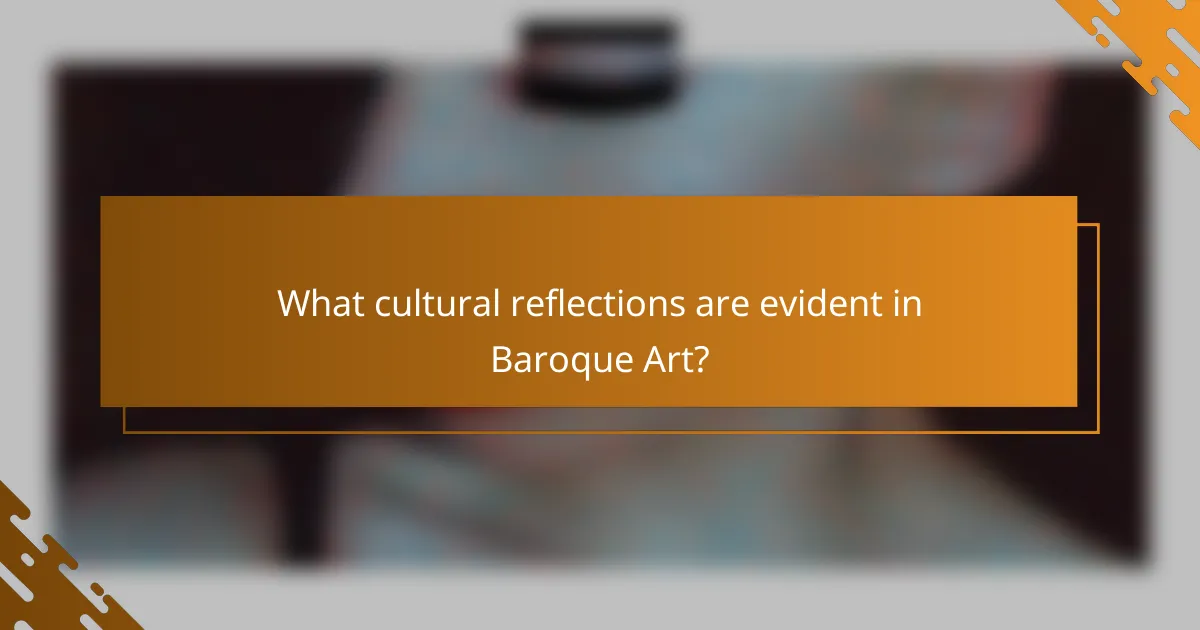
What cultural reflections are evident in Baroque Art?
Baroque Art vividly reflects the cultural dynamics of its time, showcasing the interplay between social hierarchies, religious beliefs, and political power. This artistic movement, flourishing from the late 16th to the early 18th century, serves as a mirror to the societal values and conflicts of the era.
Representation of social hierarchies
Baroque Art often emphasizes the distinctions between different social classes, illustrating the wealth and power of the elite. Artists like Diego Velázquez and Peter Paul Rubens portrayed nobility in grand settings, adorned with luxurious clothing and opulent surroundings, which reinforced their status.
In contrast, artworks also depicted the struggles of the lower classes, highlighting their hardships and resilience. This dual representation allowed viewers to understand the complexities of social structures during the Baroque period.
Religious themes in Baroque paintings
Religious themes are central to Baroque Art, reflecting the era’s deep connection to spirituality and faith. Many artists created works that depicted biblical stories and saints, using dramatic lighting and emotional expressions to evoke a sense of divine presence.
The Counter-Reformation significantly influenced this aspect, as the Catholic Church commissioned numerous artworks to inspire devotion and convey religious messages. For example, Caravaggio’s use of chiaroscuro not only highlighted the figures but also intensified the spiritual experience for the viewer.
Influence of political power on art
Political power played a crucial role in shaping Baroque Art, as rulers often used it to project their authority and legitimacy. Monarchs like Louis XIV of France commissioned grandiose works that celebrated their reign and the glory of the state, such as the elaborate decorations of the Palace of Versailles.
Art became a tool for propaganda, with artists crafting images that glorified the ruling class and their achievements. This relationship between art and politics underscores how Baroque Art served not only aesthetic purposes but also as a means of social control and influence.

How did Baroque Art drive artistic innovation?
Baroque Art significantly advanced artistic innovation through its emphasis on dramatic expression, emotional depth, and new techniques. This period introduced methods that transformed the visual arts, making them more dynamic and engaging for viewers.
Introduction of chiaroscuro techniques
Chiaroscuro, the use of strong contrasts between light and dark, became a hallmark of Baroque Art. Artists like Caravaggio employed this technique to create a sense of volume and depth, enhancing the emotional impact of their works. By manipulating light, they directed the viewer’s attention to focal points, making scenes more dramatic.
This technique not only added realism but also heightened the narrative quality of paintings, allowing artists to convey complex stories and emotions effectively. Chiaroscuro set the stage for future developments in painting, influencing generations of artists who sought to replicate its effects.
Development of dynamic compositions
Baroque artists revolutionized composition by introducing movement and tension into their works. Unlike the static arrangements of the Renaissance, Baroque compositions often featured swirling forms and diagonal lines that suggested action and energy. This dynamic approach engaged viewers, drawing them into the artwork.
Examples include the works of Peter Paul Rubens, whose paintings often depicted scenes of conflict and celebration with a sense of motion. The use of asymmetry and overlapping figures created a lively atmosphere, making the viewer feel part of the unfolding drama.
Influence on sculpture and architecture
The Baroque period also left a profound impact on sculpture and architecture, characterized by elaborate details and grandeur. Sculptors like Gian Lorenzo Bernini infused their works with emotional expression and movement, creating pieces that seemed to come alive. His famous sculpture, “The Ecstasy of Saint Teresa,” exemplifies this approach with its dynamic forms and intricate drapery.
In architecture, Baroque designs often featured bold curves, grand staircases, and expansive spaces that conveyed a sense of awe. Structures such as St. Peter’s Basilica in Vatican City exemplify the style’s emphasis on grandeur and theatricality, reflecting the cultural aspirations of the time.
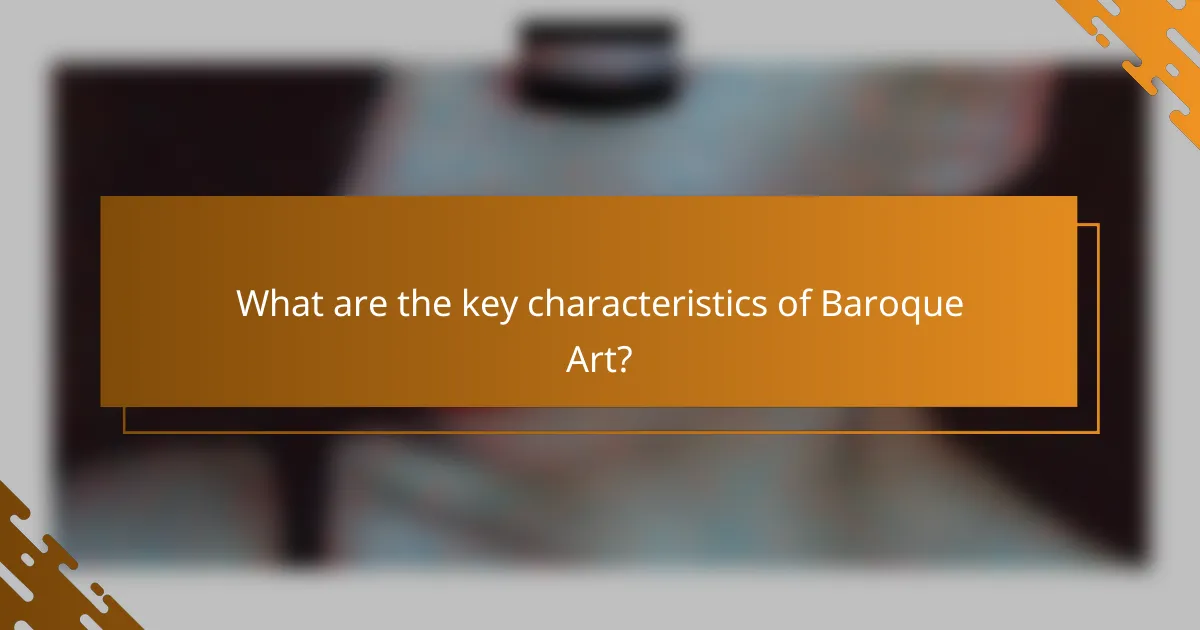
What are the key characteristics of Baroque Art?
Baroque Art is characterized by its dramatic expression, intricate details, and a strong sense of movement. This artistic style emerged in the late 16th century and is known for its emotional intensity and grandeur, often reflecting the cultural and religious tensions of the time.
Emphasis on emotion and drama
Baroque Art places a strong emphasis on conveying emotion and drama, often through dynamic compositions and expressive figures. Artists aimed to evoke feelings of awe and passion, drawing viewers into the narrative of the artwork.
For example, works like Caravaggio’s paintings utilize intense facial expressions and dramatic scenes to create a sense of immediacy. This focus on emotional depth often reflects the tumultuous social and political climate of the Baroque period.
Use of light and shadow
The use of light and shadow, known as chiaroscuro, is a hallmark of Baroque Art. Artists skillfully manipulated light to create depth, highlight important elements, and enhance the overall drama of the scene.
In paintings such as Rembrandt’s works, the contrast between light and dark not only adds dimension but also guides the viewer’s eye to focal points, enhancing the narrative. This technique was crucial in creating a three-dimensional effect on a two-dimensional surface.
Rich color palettes
Baroque artists often employed rich and vibrant color palettes to enhance the emotional impact of their works. Deep reds, golds, and blues were commonly used to convey luxury and intensity.
The choice of colors was not merely aesthetic; it also served to symbolize various themes, such as power, divinity, and passion. For instance, the use of gold in religious paintings often signifies the divine presence, while deep reds can evoke feelings of love or sacrifice.
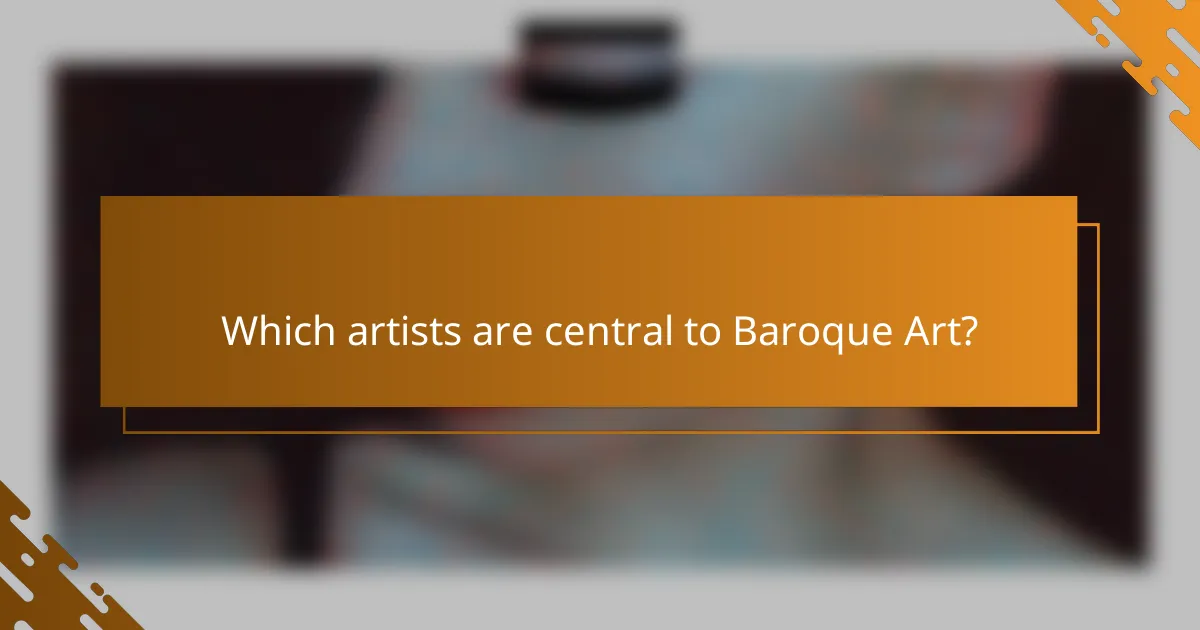
Which artists are central to Baroque Art?
Key artists central to Baroque Art include Caravaggio, Peter Paul Rubens, and Gian Lorenzo Bernini. Their innovative techniques and distinctive styles significantly shaped the movement, reflecting the cultural and emotional intensity characteristic of the Baroque period.
Caravaggio’s influence on realism
Caravaggio is renowned for his groundbreaking approach to realism, which emphasized naturalism and emotional depth. His use of chiaroscuro, the dramatic contrast between light and shadow, brought a lifelike quality to his subjects, making them relatable and immediate.
His works often depicted ordinary people in biblical scenes, challenging the idealized representations common in earlier art. This focus on realism not only influenced his contemporaries but also laid the groundwork for future movements that prioritized authenticity in art.
Peter Paul Rubens’ dynamic figures
Peter Paul Rubens is celebrated for his dynamic compositions and vibrant figures, which convey movement and energy. His ability to capture the human form in various poses, often in the context of mythological or historical narratives, set a standard for Baroque art.
Rubens’ use of color and texture added depth to his paintings, creating a sense of immediacy. His works often featured lush landscapes and dramatic scenes, reflecting the opulence of the Baroque era and appealing to the tastes of the aristocracy.
Gian Lorenzo Bernini’s sculptural mastery
Gian Lorenzo Bernini is recognized for his exceptional skill in sculpture, which brought a new level of dynamism and emotional expression to three-dimensional art. His ability to manipulate marble to create lifelike figures and intricate details is evident in masterpieces like “The Ecstasy of Saint Teresa.”
Bernini’s work often combined architecture and sculpture, creating immersive environments that engaged viewers. His contributions to the design of St. Peter’s Basilica in Vatican City exemplify his innovative approach, merging artistic vision with religious devotion.

How can Baroque Art be integrated into home decor?
Integrating Baroque art into home decor involves embracing its dramatic style, rich colors, and ornate details. This can enhance the aesthetic appeal of your space, creating a luxurious and timeless atmosphere.
Choosing the Right Color Palette
Baroque art is characterized by deep, rich colors such as gold, burgundy, and emerald green. When selecting a color palette for your decor, consider using these hues to create a cohesive look that reflects the opulence of the Baroque period.
Accent walls in dark tones or richly patterned wallpaper can serve as a stunning backdrop for Baroque-inspired furniture and artwork. Pair these colors with lighter shades to maintain balance and prevent the space from feeling too heavy.
Incorporating Ornate Furniture
Furniture plays a crucial role in achieving a Baroque-inspired decor. Look for pieces with intricate carvings, gilded finishes, and luxurious fabrics. Items such as tufted sofas, ornate mirrors, and elaborately designed tables can serve as focal points in your home.
When selecting furniture, consider the scale of your space. Large, statement pieces work well in spacious areas, while smaller, more delicate items can enhance intimacy in compact rooms.
Displaying Artwork and Accessories
Artwork is essential in Baroque decor. Consider hanging large, dramatic paintings or sculptures that reflect the grandeur of this art style. Use ornate frames to enhance the visual impact of the artwork.
In addition to paintings, accessorizing with decorative items like candlesticks, vases, and tapestries can add layers of texture and interest. Group these items in clusters for a curated look that feels both intentional and artistic.
Utilizing Lighting Effectively
Lighting is key to highlighting Baroque elements in your decor. Opt for chandeliers or sconces with intricate designs and warm lighting to create an inviting atmosphere. These fixtures not only illuminate the space but also serve as decorative statements.
Consider using dimmers to adjust the lighting intensity, allowing for a more dramatic effect during evening hours. This can enhance the overall ambiance and showcase the beauty of your Baroque-inspired decor.
